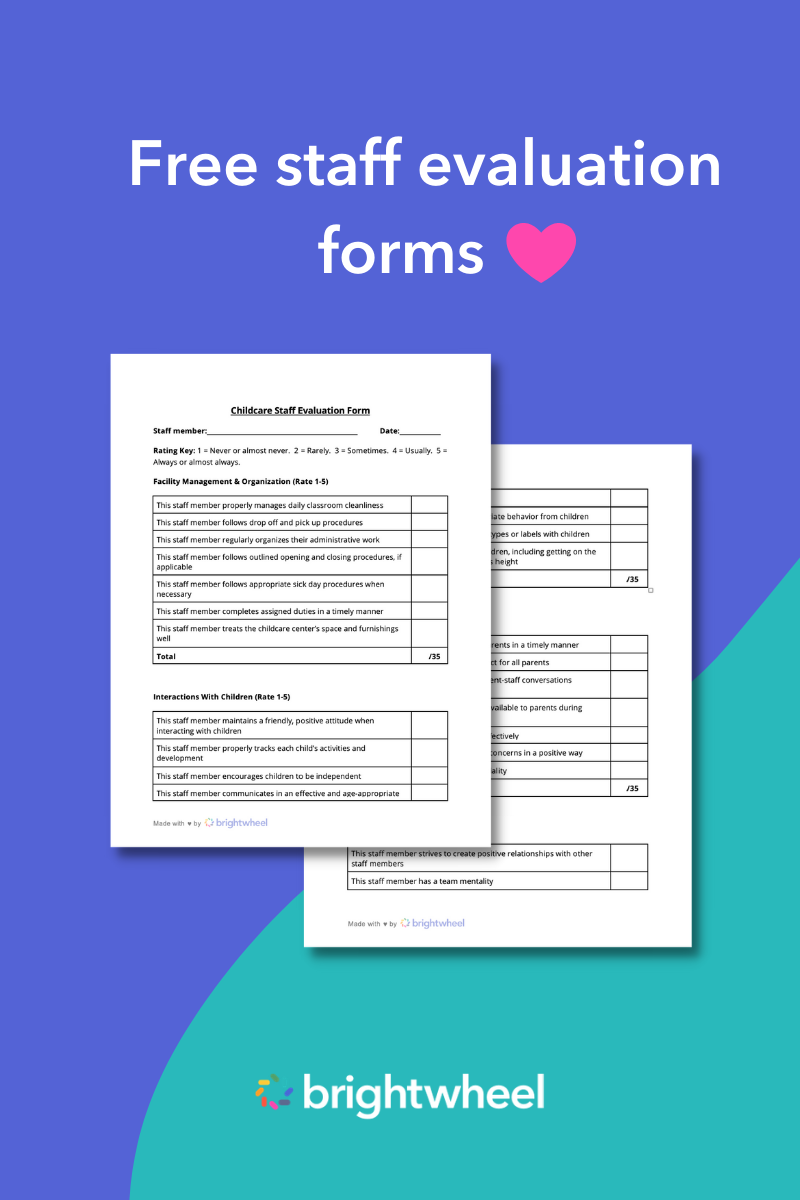Conducting staff evaluations can have a positive impact on your childcare program. Structured conversations about performance help everyone by highlighting strengths, creating a clear path for improvement, and showing how vital each person is to your program's success.
A preschool teacher evaluation form lays the groundwork for a successful performance review. It helps create a workplace culture that values feedback and professional development. This article will explore how to conduct a preschool teacher evaluation and discuss the pros and cons of linking compensation to performance reviews.
Why are preschool staff evaluations important?
Staff evaluations help each employee understand how their performance and goals contribute to the overall success of the business. Regular evaluations also help your employees feel valued and connected to their work, which can benefit everything from daily operations to long-term staff retention.
Regular preschool staff evaluations:
- Highlight areas for improvement as they arise, optimizing your workplace for growth.
- Create a positive work environment where staff receive feedback and valuable one-on-one time with their supervisor.
- Build a supportive culture where employees can develop new skills and bring fresh ideas, strengthening your program overall.
Childcare and Preschool Staff Evaluation Forms
Use this template to assess and support professional development for your childcare staff.
How to conduct a preschool teacher evaluation
With the right preparation and approach, you can make evaluation season a time that your preschool teachers look forward to. Use this time to review each staff member’s progress and achievements. It's also an opportunity for staff to express their satisfaction with their role and work environment.
Here are some best practices to keep in mind as you conduct your preschool teacher evaluations:
- Conduct evaluations annually or biannually.
- Use a comprehensive preschool teacher evaluation form.
- Require staff to complete a self-evaluation.
- Gather performance feedback from other team members.
With brightwheel's childcare forms you can easily create custom fillable PDFs and forms directly in brightwheel and share them with staff to complete. View form status, approve, or request changes in one central dashboard, saving you time and keeping your forms organized.
Conduct daycare staff evaluations annually or bi-annually
Many programs conduct formal staff evaluations once a year. However, it can also be beneficial to hold less formal check-ins every quarter.
Keep in mind that your state or country may have legal regulations determining how often you must evaluate your facility and staff. For example, Pennsylvania requires childcare program directors to provide a written evaluation for staff members at least once a year. Be sure to follow all local regulations.
Whatever frequency you choose, schedule your preschool teacher evaluations in advance so your staff has time to prepare.
You don't need to wait for a formal evaluation to use a preschool teacher evaluation form. Since these forms outline performance expectations and action plans, you can and should revisit them regularly to track progress toward goals.
Throughout the year, keep detailed notes on your staff’s achievements, strengths, and areas for growth. This will ensure you are prepared when evaluation time comes. Reference the goals from previous evaluations and note specific areas where employees continue to excel and where you’ve seen improvement.
Keep an open line of communication between you, your staff, and families with a communication app like brightwheel. Give staff an easy tool to message parents directly and foster a sense of community in your program by messaging staff individually or as a team and answering questions instantly.

Use a comprehensive preschool teacher evaluation form
Your staff evaluations should cover all responsibilities of a staff member's role. Consider each area you might include in a job description and create a section on your preschool teacher evaluation form for each one.
For example, your preschool teacher evaluation form might include these sections:
For example, your staff evaluation form might include the below sections:
- Facility management and organization: How does this staff member maintain a clean, organized learning environment?
- Interactions with children: How do they teach, speak to, and engage with children? What are their classroom behavior management skills like?
- Interactions with families: Is their communication style with families clear, respectful, and welcoming?
- Interactions with other staff: How do they interact and collaborate with other teachers and team members?
- Activity and lesson planning: Are their activities aligned with your program's learning objectives? Do they use developmentally appropriate materials?
Using a comprehensive form also ensures you provide a fair and consistent evaluation. Your staff needs to know exactly what is expected of them and how they’ll be assessed. Determine the rating scale you will use and make sure employees clearly understand what each rating means. For example, you could rate performance in each category on a scale from 1 to 5, where 1 means “never meets expectations” and 5 means “always meets expectations.”
Require staff to complete a self-evaluation
Self-evaluations are a key part of any feedback cycle. They help employees reflect on what they are good at and how they can improve. For managers, self-evaluations provide valuable insight into an employee’s work habits and perspective.
The self-evaluation form should cover the same topics as your own preschool teacher evaluation form and use the same rating scale. To get the most out of this process, compare the self-evaluation to the manager's assessment. Any differences can reveal blind spots for both staff and managers, providing a valuable opportunity to get on the same page.
Gather performance feedback from other team members
Peer feedback, also known as a 360-degree review, is an effective way to get a holistic view of a staff member's performance on larger teams. Here are a few things to consider when conducting a 360-degree review:
- Understand team dynamics. Be aware of the pros and cons of conducting a 360 review. Some team dynamics may not be suitable for peer feedback if the team is experiencing challenges or conflict.
- Set up staff for success. Giving and receiving feedback can be uncomfortable. In advance, share the purpose of a 360 review and create a safe space to discuss how the results will be used to support them professionally.
- Use the same review for everyone. Using the same feedback form and questions for everyone participating in the review will eliminate bias and assist in gathering a true account of an individual’s performance.
As a director, you might observe a staff member’s organization and timeliness, while their colleagues can assess their collaboration style and interactions with families. Multiple reviews can also help eliminate bias.
How to give constructive feedback
Many managers struggle with how to phrase constructive feedback in a way that is both direct and encouraging. Using clear and supportive language can make difficult conversations more productive.
Here are some sample phrases for common scenarios:
- For tardiness: "I've noticed you've been arriving late a few times over the past two weeks. It's important that you're here on time to help us maintain ratios and greet the children as they arrive. What can we do to ensure you can get here by 8:00 AM each morning?"
- For classroom management issues: "I saw that managing transition times has been a challenge recently. Let's brainstorm some new strategies together. I was thinking we could try using a visual timer or a transition song. What are your thoughts?"
- For communication with families: "I'd like to see you share more individual updates with families. Let's set a goal for you to send at least three positive, personalized messages to different families each week using the brightwheel app. This can help build stronger connections and keep them engaged."
Pros and cons of tying compensation to performance evaluations
Connecting compensation discussions to performance evaluations can be beneficial, but it's important to consider various factors.
Pros of linking pay to performance
- Motivates staff: A potential pay increase can reward a job well done and encourage great work to continue.
- Attracts talent: A compensation plan that includes a performance element can attract high-performing and ambitious candidates.
- Offers clear metrics for pay increases: Performance-based pay provides clarity and consistency. You can be specific about what type of work merits an increase in pay.
Cons of linking pay to performance
Depending on what makes the most sense for your business, you may decide to evaluate the idea of keeping compensation conversations separate from performance reviews.
- Distracts from feedback: Sometimes when job performance and compensation are discussed together, the feedback can get lost if the staff member is solely focused on the pay portion.
- Takes time to set up: With a performance-based pay model, it's important to set up clear tiers and milestones so employees understand what they need to do to receive a change in pay. This can be time-consuming to build and maintain.
Reviewing these options as they apply to your own business and individual staff members can help you to decide whether or not this performance evaluation structure is right for you.
Implement preschool staff evaluations to meet and exceed your goals
Every owner or director of a childcare program wants to make their workplace the best it can be for the children in their care and for their employees—which is easier said than done.
Conducting staff evaluations is one of the best ways to show your staff that you are invested in their professional development and value their impact on your business. Using a tool like a preschool teacher evaluation form is a great way to track each staff members’ unique strengths and contributions towards meeting and exceeding your childcare program's goals.


